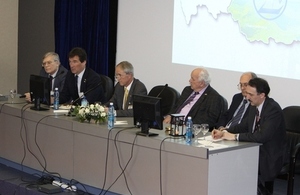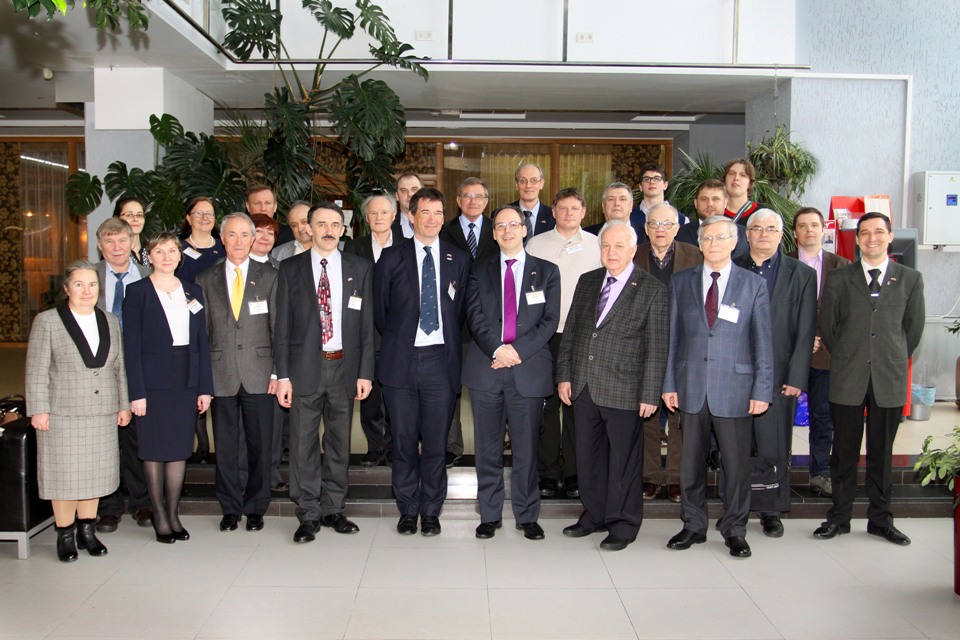UK-Russia Synchrotron roundtable in Novosibirsk
On 26 February, SIN Russia held a UK-Russia Science Roundtable on Accelerator Science in Akademgorodok (Novosibirsk).

The event was organized by SIN Russia in partnership with Budker Institute of Nuclear Physics (BINP, Novosibirsk Academgorodok), the British Consulate General in Ekaterinburg, and the Siberian Branch of the Russian Academy of Sciences to enhance UK-Russia scientific cooperation in the field and encourage joint projects on accelerators for medical, industrial and scientific purposes.
The event brought together some of the leading UK and Russian scientists. The British side was represented by Prof. Andrei Seryi (Director of John Adams Institute for Accelerator Physics, University of Oxford), Prof. Andrew Harrison (CEO Diamond Light Source Ltd) and Prof. Richard Walker (Technical Director at Diamond Light Source Ltd). Some of the Russian keynote speakers were Prof. Gennady Kulipanov (Director of the Siberian Centre for Synchrotron and Terahertz Radiation), Prof. Eugene Levichev (Deputy Director BINP), and Prof. Vladimir Korchuganov (Director of the Kurchatov Centre for Synchrotron-Neutron Research, Moscow).
The programme of the round table covered talks by the Russian and British scientists in the field of accelerator science and synchrotron light sources. One of the first speakers, Prof. Kulipanov made a comprehensive overview of 40-years of UK-Russia collaboration in the field of synchrotron radiation use. In the course of the event, CEO Diamond Light Source Ltd, Prof. Andrew Harrison presented the Diamond synchrotron complex, the largest UK-funded scientific facility in operation since 2007 and the world’s largest medium-energy synchrotron. Third-generation dedicated synchrotron light source, Diamond has 24 beamlines on stream and boasts over 3000 users from both academia and industry. Its highly focused beams of light enable examination of complex systems and the light source is widely used for academic and industry R&D across a range of scientific disciplines including structural biology, physics, chemistry, materials science, and engineering. A telling example, over 40% of Diamond’s research is in the life sciences and it ranks third in the world with the number of protein structures solved at the facility and deposited in the World Protein Databank. Prof. Harrison gave an insightful and exciting overview of Diamond’s capabilities, encouraging Russian scientists to become Diamond users (although free for academic research, access to beamlines is provided on the peer-review basis). Prof. Walker’s informative talk focused more on the technical side of things as he elucidated Diamond’s light source lattice (= structure) and its upgrade plans.
HMG Consul General in Ekaterinburg Mr. Jon Sharp attended the round table. In his welcome speech Mr. Sharp stressed the strong UK-Russia science links and expressed hope that UK and Russian scientists will pursue fruitful scientific collaboration in the future. The round table event presented leading UK and Russian scientists an opportunity to discuss state-of-the-art approaches to synchrotron radiation technology. It triggered a productive discussion on the possibilities of UK-Russia jointly developing novel compact synchrotron light sources destined to revolutionisе medical diagnostics and therapy and, thus, change the face of today’s medicine. The roundtable culminated in a reception for leading UK and Russia scientists hosted by Jon Sharp and Academician Kulipanov, offering an excellent opportunity both for networking and furthering the exchange of views on bilateral cooperation prospects in the field of synchrotron radiation use. For photos of the event, please visit.
As part of their science programme in Novosibirsk, SIN Russia and HMG Consul General in Ekaterinburg, Jon Sharp visited Budker Institute of Nuclear Physics, familiarizing themselves with its research potential and infrastructure. One of the world’s leading centres in the field of high-energy physics and accelerators science, plasma physics and controlled thermonuclear fusion, the Institute carries out large-scale experiments on particle physics using electron-positron colliders and is a widely recognized world leader in development of facilities to generate super-bright synchrotron radiation. As the final stage of their visit, HMG Consul General and SIN Russia had a productive meeting with the Director of the world-famous Boreskov Institute of Catalysis Academician Valentin Parmon. Boreskov Institute is a key partner for the UK-Russia UNIHEAT project facilitated by SIN Russia.
